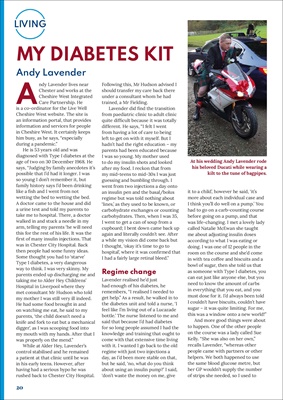
20
LIVING
MY DIABETES KIT
Andy Lavender
Andy Lavender lives near
Chester and works at the
Cheshire West Integrated
Care Partnership. He
is a co-ordinator for the Live Well
Cheshire West website. The site is
an information portal, that provides
information and services for people
in Cheshire West. It certainly keeps
him busy, as he says, "especially
during a pandemic."
He is 53 years old and was
diagnosed with Type I diabetes at the
age of two on 30 December 1968. He
says, "Judging by family anecdotes it's
possible that I'd had it longer. I was
so young I don't remember it, but
family history says I'd been drinking
like a fish and I went from not
wetting the bed to wetting the bed.
A doctor came to the house and did
a urine test and told my parents to
take me to hospital. There, a doctor
walked in and stuck a needle in my
arm, telling my parents 'he will need
this for the rest of his life. It was the
first of many insulin injections. That
was in Chester City Hospital. Back
then people had some funny ideas.
Some thought you had to 'starve'
Type 1 diabetes, a very dangerous
way to think. I was very skinny. My
parents ended up discharging me and
taking me to Alder Hey Childrens'
Hospital in Liverpool where they
met consultant Mr Hudson who told
my mother I was still very ill indeed.
He had some food brought in and
on watching me eat, he said to my
parents, 'the child doesn't need a
knife and fork to eat but a mechanical
digger', as I was scooping food into
my mouth with my hands. After that I
was properly on the mend."
While at Alder Hey, Lavender's
control stabilised and he remained
a patient at that clinic until he was
in his early teens. However, after
having had a serious hypo he was
rushed back to Chester City Hospital.
Following this, Mr Hudson advised I
should transfer my care back there
under a consultant whom he had
trained, a Mr Fielding.
Lavender did find the transition
from paediatric clinic to adult clinic
quite difficult because it was totally
different. He says, "I felt I went
from having a lot of care to being
left to get on with it myself. But I
hadn't had the right education - my
parents had been educated because
I was so young. My mother used
to do my insulin shots and looked
after my food. I reckon that from
my mid-teens to mid-30s I was just
guessing and bumbling through. I
went from two injections a day onto
an insulin pen and the basal/bolus
regime but was told nothing about
'lines,' as they used to be known, or
carbohydrate exchanges or counting
carbohydrates. Then, when I was 35,
I went to get a can of soup from a
cupboard; I bent down came back up
again and literally couldn't see. After
a while my vision did come back but
I thought, 'okay it's time to go to
hospital', where it was confirmed that
I had a fairly large retinal bleed."
Regime change
Lavender realised he'd just
had enough of his diabetes, he
remembers, "I realised I needed to
get help." As a result, he walked in to
the diabetes unit and told a nurse, 'I
feel like I'm living out of a Lucazade
bottle.' The nurse listened to me and
said that because I'd had diabetes
for so long people assumed I had the
knowledge and training that ought to
come with that extensive time living
with it. I wanted I go back to the old
regime with just two injections a
day, as I'd been more stable on that,
but he said, 'no, what do you think
about using an insulin pump?' I said,
'don't waste the money on me, give
it to a child', however he said, 'it's
more about each individual case and
I think you'll do well on a pump.' You
had to go on a carb-counting course
before going on a pump, and that
was life-changing. I met a lovely lady
called Natalie McEwan she taught
me about adjusting insulin doses
according to what I was eating or
doing. I was one of 12 people in the
room on the course and she'd come
in with tea coffee and biscuits and a
bowl of sugar, then she told us that
as someone with Type I diabetes, you
can eat just like anyone else, but you
need to know the amount of carbs
in everything that you eat, and you
must dose for it. I'd always been told
I couldn't have biscuits, couldn't have
sugar - it was quite limiting. For me,
this was a window onto a new world!"
And more good things were about
to happen. One of the other people
on the course was a lady called Sue
Kelly. "She was also on her own,"
recalls Lavender, "whereas other
people came with partners or other
helpers. We both happened to use
the same blood glucose metre, but
her GP wouldn't supply the number
of strips she needed, so I used to
At his wedding Andy Lavender
rode his beloved Ducati while
wearing a kilt.